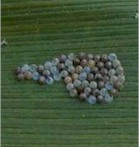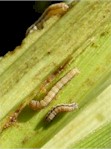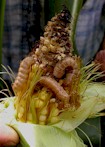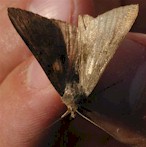Entomologist: Corn pest an earful of bad news for farmers
By Steve Leer
Purdue Exponent
August 4, 2006
 |
 |
 |
 |
WBC egg mass |
WBC larvae |
WBC feeding |
WBC adult |
Photos by: Dow AgroSciences LLC |
WEST LAFAYETTE, Ind. - An insect that attacks maturing corn could make life more difficult for Eastern Corn Belt farmers in the years to come.
The western bean cutworm (WBC) has migrated into Indiana from Illinois and states further west, said Christian Krupke, Purdue University Extension entomologist. While the pest isn't expected to cause crop damage this year, corn growers will want to keep an eye on the insect from now on.
"The western bean cutworm is a moth in the same family of moths as the corn earworm," Krupke said. "In fact, it could be confused with corn earworm because the western bean cutworm is also a late-season pest that feeds on corn ears.
"One key difference between the two pests is that you can have more than one western bean cutworm larvae on an ear of corn, whereas the corn earworm is cannibalistic so you'll only have one corn earworm larvae per ear. So at least from that standpoint, you have the potential for more damage with the western bean cutworm."
Based on WBC feeding in Iowa and Nebraska, yield loss of a few bushels per acre is possible, Krupke said.
Purdue Extension specialists have been monitoring the insect's eastern migration. This year they began capturing WBC moths in traps set across Indiana.
"Western bean cutworm has been steadily moving east from Nebraska in recent years," Krupke said. "In the last several years it spread from Nebraska to Iowa, where some of the highest populations have been found.
"Last year the pest was found in Illinois. We started trapping the moths in Indiana this year, as well as Wisconsin, Michigan and Ohio. We found moths in all of those states. The highest concentrations of western bean cutworm moths we've found in Indiana are in northwest part of the state, closest to the sites of infestation in Illinois. We've also found moths in eastern counties, such as Randolph and Whitley. It is important to note, however, that the moth numbers are not very high and we haven't documented any damage by the pest yet in Indiana."
There are insecticide treatments and at least one Bt corn variety effective in controlling the pest, Krupke said. Because moth numbers are low he does not recommend growers treat their fields at this time.
"We would recommend growers scout their fields for this pest," he said. "Scouting methods are like those for corn earworm. Start in July and look at plant leaves for eggs. Also look for larval feeding."
Western bean cutworm moths are dark brown with a white stripe on their upper wings and measure about three-fourths of an inch long. Larvae are about one-quarter inch long when hatched and can grow to a length of 1.5 inches. Young larvae are tan and become a pale brown as they develop. Older larvae have three light stripes on the back of their heads.
"There's one generation of western bean cutworm each year," Krupke said. "Adult moths emerge in early July, move into cornfields and lay 20 to 50 eggs on the upper surface of corn leaves. The eggs hatch and the larvae will feed in the whorl for the early part of their life cycles. Once the tassel emerges they'll feed on the tassels. They'll eventually move into the ear and silks, where they will conclude their feeding for the season.
"In the worst-case scenarios, you may see a four-bushel-per-acre yield loss, which is significant. But even in places like Iowa where the pest is more prevalent, the western bean cutworm isn't a key pest - it's more of a hotspot sort of insect, with some damage in some fields. You don't tend to see a 50-acre field entirely wiped out by this pest."
WBC overwinters as late-stage larvae in fields, Krupke said.
So how does a corn pest get the name western "bean" cutworm?
"The pest first was identified as a problem in dry beans, and then began to show up in corn," Krupke said. "Corn and dry beans continue to be the two main crops western bean cutworm feed on. But you'll also see them in popcorn, sweet corn and, sometimes, tomatoes and peppers. Like corn earworm, it has a number of hosts that it can use to complete development."
Growers who suspect their fields contain WBC larvae are encouraged to report possible infestation to Krupke at (765) 494-4912 or by e-mail at ckrupke@purdue.edu; or contact their county office of Purdue Extension.
"Producers also can take a digital photo of a living larva and e-mail it to us, or send us a larva that they've found," Krupke said.
For more information on crop pests, visit Purdue's field crops integrated pest management Web site online.
Writer: Steve Leer, (765) 494-8415, sleer@purdue.edu
Source: Christian Krupke, (765) 494-4912, ckrupke@purdue.edu
Ag Communications: (765) 494-2722; Beth Forbes, forbes@purdue.edu |